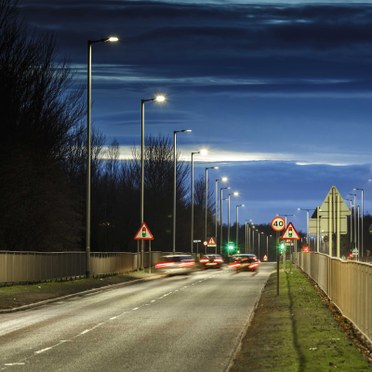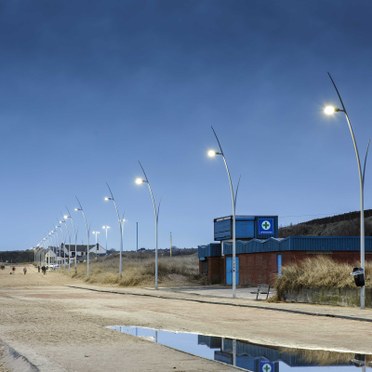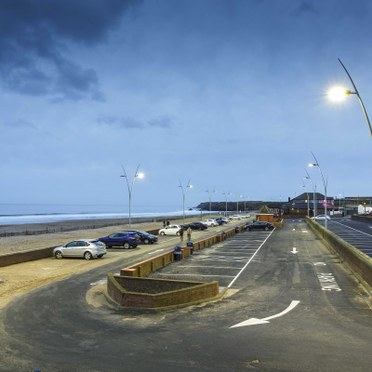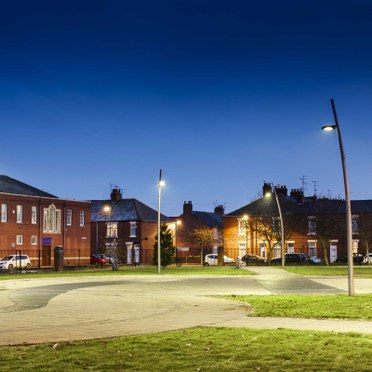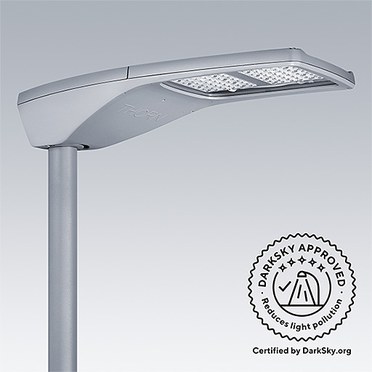South Tyneside, UK
Products
- Lamp efficacy
Lamp efficacy
Ensuring the lamp efficiently converts electricity into light (lm/W).
- Ballast classification
Ballast classification
Controlling the electricity supply to the lamp (Energy Efficiency Index).
- Luminaire distribution
Luminaire distribution
Controlling light emission using optics which bend and shape the light to the correct location.
- System efficacy
System efficacy
Combining optical and thermal control within the luminaire (luminaire lm/W).
- Presence/absence detection
Presence/absence detection
Presence: Lights automatically turn on/off with movement. Absence: Lights automatically turn off and must be manually switched on.
- Daylight detection
Daylight detection
Artificial lighting which responds to the natural light conditions.
- Constant illuminance
Constant illuminance
A function designed to produce correct light levels for the duration of the maintenance period.
- Task-scene setting
Task-scene setting
Allowing the user to set scenes and adapt the lighting to different tasks.
- Timed off
Timed off
Automatic cut-off can be installed to turn all lights off during unoccupied hours.
- Task lighting
Task lighting
Lighting task areas with the correct amount of light.
- Zoning of lighting
Zoning of lighting
Lighting is zoned according to area use.
- Maintenance schedule
Maintenance schedule
Maintenance must be performed in response to product age, performance and environment.
- Waste light
Waste light
Eliminating waste light which does not hit the intended target.
- Reflectance
Reflectance
Taking advantage of light which is reflected from the surface within the space.
- Visible smart metering
Visible smart metering
Results of actions can be quickly seen as increased or decreased energy use to encourage responsible energy consumption.
Background
Thorn Lighting has supplied over 5000 LED R2L2 lanterns as part of a retrofit project by South Tyneside Council (STC) that will replace street lighting on major infrastructures and residential highways in the area. The project has already shown impressive payback figures, with energy saving calculations of over £200,000 per annum.
Grahame Clennell, Senior Design Engineer, Balfour Beatty stated ”Our brief was to replace and reduce high energy lanterns used on South Tyneside’s highways and replace them with low wattage LED equivalents. The Thorn R2L2 lanterns fitted our specification and calculations showed the percentage energy savings were approximately 58% which equated to an annual energy saving of just over £200,000 based on
a 10.4p per KWhr energy cost”.
Lighting objectives
STC’s lighting replacement scheme was spread over two phases with Phase I being the replacement of lanterns with high wattage lamps of 250W/150W on major roads and Phase II replacing 100W/70W lamps and lanterns in residential areas. Thorn’s R2L2 lantern was the perfect choice as the fitting comes in three sizes and has extensive optical, lumen and light distribution choices for all road applications up to ME1.
The 11 types of light distribution offered by the lantern’s optics deliver the precise light placement and, perhaps more importantly, no wasted light. Energy savings can also be maximised with a wide range of intelligent lighting control solutions from stand-alone dimming to full remote control via a central monitoring system. The R2L2 fitting also offers a universal and integrated spigot that provides flexibility through top and side entry for any maintenance and tilt adjustment.
Solution
Working closely with the main project contractors Balfour Beatty, Thorn supplied its R2L2 lantern incorporating the very latest LED technology to replace the old SON street lighting lanterns, whilst utilising the existing columns. One of the main considerations for using Thorn luminaires was the company’s strong ties to the North East via its facility in Spennymoor, which allowed both STC personnel and Balfour Beatty to visit the Thorn factory and to have close contact, should any adjustments need to be made during the project.
Councillor Moira Smith, Lead Member for Area Management and Community Safety at South Tyneside Council, said: “We are reaping the twofold benefits of this project. We have to make significant savings due to continued reductions in government funding and the LED lights have already cut our energy costs by thousands of pounds. The new system also reinforces our commitment to protecting the environment by reducing our carbon footprint.”
Download South Tyneside case study as a PDF here.

